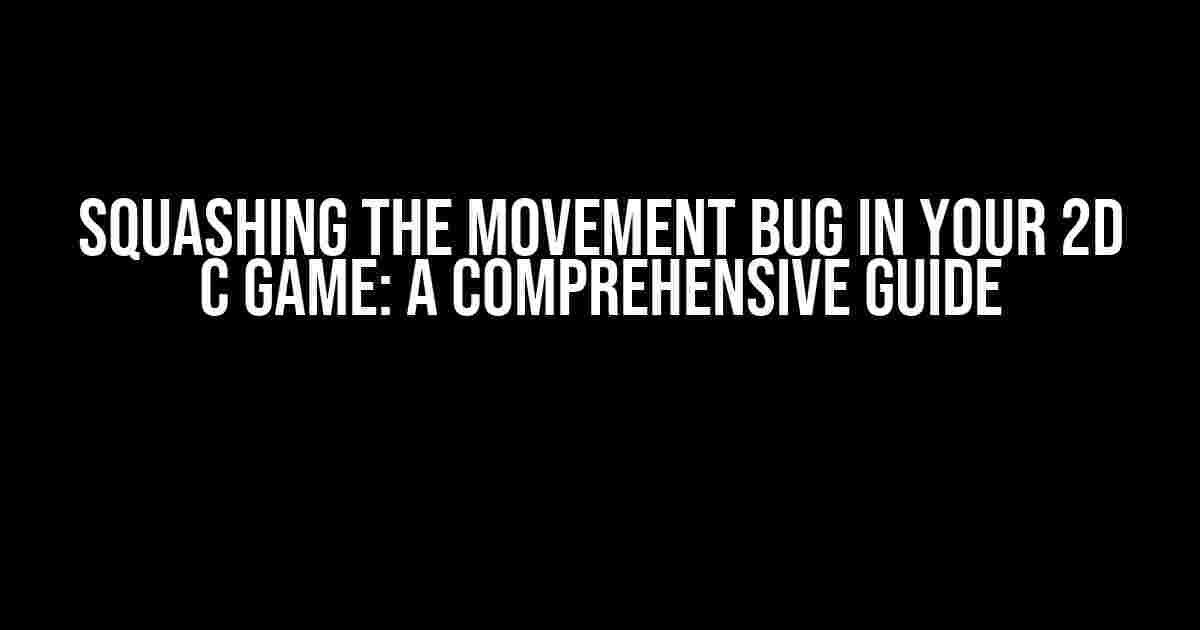Are you tired of seeing your game character slide around like they’re on a banana peel? Do your players experience the frustrating phenomenon of getting stuck in walls or clip through solid objects? You’re not alone! The movement bug in 2D C games is a common issue that can drive even the most patient developers crazy. Fear not, dear coder, for we’re about to embark on a quest to vanquish this pesky bug and bring your game back to its former glory.
What is the Movement Bug?
The movement bug, also known as the “character sliding” or “getting stuck” issue, occurs when your game character’s movement doesn’t quite align with the game’s physics. This can manifest in various ways, such as:
- Characters sliding along walls or floors
- Getting stuck in corners or crevices
- Clipping through solid objects
- Inconsistent or jerky movement
Causes of the Movement Bug
Before we dive into the solutions, let’s explore the common causes of this irritating issue:
- Incorrect collision detection and response
- Inadequate or misplaced bounding boxes
- Poorly implemented movement algorithms
- Inconsistent or incorrect use of gravity
- Insufficient or excessive use of friction
Solution 1: Revamp Your Collision Detection
// Pseudocode for collision detection
// Assume 'player' is the game character and 'wall' is the colliding object
if (player.x + player.width > wall.x &&
player.x < wall.x + wall.width &&
player.y + player.height > wall.y &&
player.y < wall.y + wall.height) {
// Handle collision response (e.g., stop movement, bounce off, etc.)
}
| Collision Type | Description | Solution |
|---|---|---|
| Rectangle-Rectangle Collision | Detecting collisions between two rectangles (e.g., player and wall) | Use the above pseudocode or a library like SDL for efficient collision detection |
| Circle-Circle Collision | Detecting collisions between two circles (e.g., player and coin) | Use the Pythagorean theorem to calculate distance between circle centers |
| Rectangle-Circle Collision | Detecting collisions between a rectangle and a circle | Use a combination of rectangle-rectangle and circle-circle collision detection |
Solution 2: Optimize Your Bounding Boxes
Bounding boxes are an essential component of collision detection. Ensure your bounding boxes are correctly sized and positioned to prevent false positives or negatives:
// Pseudocode for bounding box creation
player.boundingBox = {
x: player.x,
y: player.y,
width: player.width,
height: player.height
};
Tip: Use a debugging tool or visualization to see your bounding boxes in action. This will help you identify and fix any issues.
Solution 3: Fine-Tune Your Movement Algorithm
A well-crafted movement algorithm is crucial for smooth, predictable movement. Here are some tips to fine-tune your movement algorithm:
- Use a consistent movement speed and acceleration
- Implement friction to slow down movement over time
- Use gravity to affect vertical movement
- Avoid using魔法数字(magic numbers) for movement values; instead, use constants or variables
// Pseudocode for basic movement algorithm
void movementAlgorithm() {
// Horizontal movement
player.x += player.speed * cos(player.direction);
// Vertical movement
player.y += player.speed * sin(player.direction);
// Apply friction
player.speed *= 0.95;
// Apply gravity
player.y += gravity;
}
Solution 4: Debug and Refine
Debugging is an essential step in squashing the movement bug. Here are some tips to help you refine your game:
- Use console logs or a debugging tool to monitor player movement and collision detection
- Visualize your bounding boxes and collision shapes to identify issues
- Test your game on different devices and platforms to ensure consistency
- Playtest your game regularly to catch any movement-related issues
Conclusion
The movement bug can be a frustrating and elusive issue, but with these solutions, you're well on your way to banishing it from your 2D C game. Remember to:
- Revamp your collision detection for accurate and efficient results
- Optimize your bounding boxes for precise collision detection
- Fine-tune your movement algorithm for smooth, predictable movement
- Debug and refine your game regularly to catch any movement-related issues
By following these steps, you'll be able to create a seamless gaming experience that will leave your players delighted and enthralled. Happy coding!
SEO Keywords: movement bug, 2D C game, collision detection, bounding boxes, movement algorithm, debugging, game development
Frequently Asked Question
Get ahead of the game by understanding the common issues and solutions to the movement bug in 2D C games!
What is a movement bug in a 2D C game?
A movement bug in a 2D C game occurs when the game's character or object moves unexpectedly or erratically, disrupting the gameplay experience. This bug can be caused by various issues, such as incorrect velocity calculations, misplaced collision detection, or even a simple typo in the code!
What are the common causes of movement bugs in 2D C games?
Some of the most common causes of movement bugs in 2D C games include incorrect acceleration and deceleration rates, misplaced or malfunctioning collision detection, and even incorrect character or object positioning. Sometimes, it can be as simple as a misplaced semicolon or a typo in the code!
How do I troubleshoot a movement bug in my 2D C game?
To troubleshoot a movement bug, start by checking the game's logs and debug outputs to identify the source of the issue. Then, review your code line by line, paying attention to any calculations, collisions, or positioning that might be causing the bug. If all else fails, try isolating the issue by commenting out sections of code or using a debugger to step through the game's logic!
Can a movement bug be caused by a physics engine issue?
Yes, a movement bug can be caused by a physics engine issue! Physics engines, such as Box2D or Godot, can sometimes produce unexpected results or behave erratically, leading to movement bugs. Make sure to check the physics engine's documentation and configuration to ensure that it's set up correctly and functioning as expected!
How can I prevent movement bugs in my 2D C game?
To prevent movement bugs, make sure to thoroughly test your game's movement mechanics, and consider using a robust testing framework to catch any issues early on. Additionally, keep your code organized, commented, and reviewed regularly to catch any potential errors or typos. Finally, don't be afraid to ask for help or collaborate with other developers to get a fresh pair of eyes on your code!


